Assessing the Effects of Climate Change on the Hydrology of a Small Catchment: The Krapina River near Kupljenovo
Abstract
1. Introduction
2. Materials and Methods
2.1. Description of the Basin and Used Data
2.2. Methods
3. Results and Discussion
3.1. Characteristic Annual Discharges
3.2. Annual Precipitation
3.3. Mean Annual Air Temperatures
3.4. Relationship Between Mean Annual Discharges, Annual Precipitation, and Mean Annual Air Temperatures
3.5. Annual Runoff Coefficients
3.6. New Drought Index (NDI) and Standardized Streamflow Index (SQI)
4. Conclusions and Guidelines for Future Investigations
Author Contributions
Funding
Data Availability Statement
Conflicts of Interest
References
- Arnell, N. Climate change and global water resources. Glob. Environ. Change 1999, 9, S31–S49. [Google Scholar] [CrossRef]
- Intergovernmental Panel on Climate Change. Climate Change Widespread, Rapid, and Intensifying—IPCC. 2021. Available online: https://www.ipcc.ch/2021/08/09/ar6-wg1-20210809-pr (accessed on 25 March 2025).
- Huntington, T.G. Evidence for intensification of the global water cycle: Review and synthesis. J. Hydrol. 2006, 319, 83–95. [Google Scholar] [CrossRef]
- Hansen, J.E.; Kharecha, P.; Sato, M.; Tselioudis, G.; Kelly, J.; Bauer, S.E.; Ruedy, R.; Jeong, E.; Jin, Q.; Rignot, E.; et al. Global Warming Has Accelerated: Are the United Nations and the Public Well-Informed? Environ. Sci. Policy Sustain. Dev. 2025, 67, 6–44. [Google Scholar] [CrossRef]
- Alkama, R.; Marchand, L.; Ribes, A.; Decharme, B. Detection of global runoff changes: Results from observations and CMIP5 experiments. Hydrol. Earth Syst. Sci. 2013, 17, 2967–2979. [Google Scholar] [CrossRef]
- Douville, H.; Allan, R.P.; Arias, P.A.; Betts, R.A.; Caretta, M.A.; Cherchi, A.; Mukherji, A.; Raghavan, K.; Renwick, J. Water remains a blind spot in climate change policies. PLoS Water 2022, 1, e0000058. [Google Scholar] [CrossRef]
- Müller, O.V.; McGuire, P.C.; Vidale, P.L.; Hawkins, E. River flow in the near future: A global perspective in the context of a high-emission climate change scenario. Hydrol. Earth Syst. Sci. 2024, 28, 2179–2201. [Google Scholar] [CrossRef]
- Yang, Y.; Roderick, M.L.; Guo, H.; Miralles, D.G.; Zhang, L.; Fatichi, S.; Luo, X.; Zhang, Y.; McVicar, T.R.; Tu, Z.; et al. Evapotranspiration on a greening Earth. Nat. Rev. Earth Environ. 2023, 4, 626–641. [Google Scholar] [CrossRef]
- van Vliet, M.T.; Franssen, W.H.; Yearsley, J.R.; Ludwig, F.; Haddeland, I.; Lettenmaier, D.P.; Kabat, P. Global river discharge and water temperature under climate change. Glob. Environ. Change 2013, 23, 450–464. [Google Scholar] [CrossRef]
- Milly, P.C.D.; Dunne, K.A.; Vecchia, A.V. Global pattern of trends in streamflow and water availability in a changing climate. Nature 2005, 438, 347–350. [Google Scholar] [CrossRef]
- Abbas, M.; Zhao, L.; Wang, Y. Perspective impact on water environment and hydrological regime owing to climate change: A review. Hydrology 2022, 9, 203. [Google Scholar] [CrossRef]
- Dai, A.; Qian, T.; Trenberth, K.E.; Milliman, J.D. Changes in Continental Freshwater Discharge from 1948 to 2004. J. Clim. 2009, 22, 2773–2792. [Google Scholar] [CrossRef]
- Gudmundsson, L.; Boulange, J.; Do, H.X.; Gosling, S.N.; Grillakis, M.G.; Koutroulis, A.G.; Leonard, M.; Liu, J.; Schmied, H.M.; Papadimitriou, L.; et al. Globally observed trends in mean and extreme river flow attributed to climate change. Science 2021, 371, 1159–1162. [Google Scholar] [CrossRef] [PubMed]
- Douglas, E.; Vogel, R.; Kroll, C. Trends in floods and low flows in the United States: Impact of spatial correlation. J. Hydrol. 2000, 240, 90–105. [Google Scholar] [CrossRef]
- Tigkas, D.; Vangelis, H.; Tsakiris, G. Drought and climatic change impact on streamflow in small watersheds. Sci. Total. Environ. 2012, 440, 33–41. [Google Scholar] [CrossRef]
- Bonacci, O. Factors affecting variations in the hydrological cycle at different temporal and spatial scales. Acta Hydrotech. 2023, 36, 1–15. [Google Scholar] [CrossRef]
- Tsegaw, A.T.; Pontoppidan, M.; Kristvik, E.; Alfredsen, K.; Muthanna, T.M. Hydrological impacts of climate change on small ungauged catchments—Results from a global climate model–regional climate model–hydrologic model chain. Nat. Hazards Earth Syst. Sci. 2020, 20, 2133–2155. [Google Scholar] [CrossRef]
- Pumo, D.; Caracciolo, D.; Viola, F.; Noto, L.V. Climate change effects on the hydrological regime of small non-perennial river basins. Sci. Total. Environ. 2016, 542, 76–92. [Google Scholar] [CrossRef]
- De Girolamo, A.; Barca, E.; Leone, M.; Porto, A.L. Impact of long-term climate change on flow regime in a Mediterranean basin. J. Hydrol. Reg. Stud. 2022, 41, 101061. [Google Scholar] [CrossRef]
- Aykut, T.; Turoğlu, H. Effects of climate change on streamflow in NE Edirne (NW Türkiye): Implications for sustainable hydrological development. Sustain. Water Resour. Manag. 2023, 10, 2. [Google Scholar] [CrossRef]
- Ribes, A.; Qasmi, S.; Gillett, N.P. Making climate projections conditional on historical observations. Sci. Adv. 2021, 7, eabc0671. [Google Scholar] [CrossRef]
- Frayer, D.W. The Krapina Neandertals—A Comprehensive, Centennial, Illustrated Bibliography; Croatian Natural History Museum: Zagreb, Croatia, 2006. [Google Scholar]
- Frayer, D.W.; Radovčić, J.; Radovčić, D. Krapina and the Case for Neandertal Symbolic Behavior. Curr. Anth. Curr. Anthropol. 2020, 61, 713–731. [Google Scholar] [CrossRef]
- Ivezić, V.; Bekić, D.; Horvat, B. Modelling of basin wide daily evapotranspiration with a partial integration of remote sensing data. Atmosphere 2018, 9, 120. [Google Scholar] [CrossRef]
- Orešić, D. Morfografski pokazatelji porječja Krapine. Acta Geogr. Croat. 1995, 30, 29–38. [Google Scholar]
- Orešić, D.; Filipčić, A. Promjene protočnih režima najvećih Savskih i Dravskih pritoka u Hrvatskom Zagorju i gornjoj Podravini 1961–2020. Podravina 2024, 23, 33–52. [Google Scholar]
- Orešić, D. Osnovne značajke režima tekućica poriječja Krapine. Hrvat. Geogr. Glas. 1995, 57, 37–53. [Google Scholar]
- Köppen, W.; Geiger, R. Handbuch der Klimatologie: Das Geographische System der Klimate; Verlag vod Gebrüder Born-traeger: Berlin, Germany, 1936. [Google Scholar]
- Filipčić, A. Klimatska regionalizacija Hrvatske po W. Köppenu za standardno razdoblje 1961–1990 u odnosu na razdoblje 1931–1960. Acta Geogr. Croat 1998, 33, 7–14. [Google Scholar]
- Šegota, T.; Filipčić, A. Köppenova podjela klima i hrvatsko nazivlje. Geoadria 2003, 8, 17–37. [Google Scholar] [CrossRef]
- Čanjevac, I. Tipologija protočnih režima rijeka u Hrvatskoj. Hrvat. Geogr. Glas. 2013, 75, 23–42. [Google Scholar] [CrossRef]
- Čanjevac, I.; Orešić, D. Contemporary changes of mean annual and seasonal river discharges in Croatia. Hrvat. Geogr. Glasnik 2015, 77, 7–27. [Google Scholar] [CrossRef]
- Chaddock, R.E. Principles and Methods of Statistics; Houghton Mifflin: Cambridge, UK, 1925. [Google Scholar]
- Borovskaya, R.; Krivoguz, D.; Chernyi, S.; Kozhurin, E.; Khorosheltseva, V.; Zinchenko, E. Surface water salinity evaluation and identification for using remote sensing data and machine learning approach. J. Mar. Sci. Eng. 2022, 10, 257. [Google Scholar] [CrossRef]
- Jobson, J.D. Multiple linear regression. In Applied Multivariate Data Analysis. Springer Texts in Statistics; Springer: New York, NY, USA, 1991. [Google Scholar] [CrossRef]
- Garbrecht, J.; Fernandez, G.P. Visualization of trends and fluctuations in climatic records. Water Res. Bull. 1994, 30, 297–306. [Google Scholar] [CrossRef]
- Bonacci, O.; Žaknić-Ćatović, A.; Roje-Bonacci, T. Prominent Increase in Air Temperatures on Two Small Mediterranean Islands, Lastovo and Lošinj, Since 1998 and Its Effect on the Frequency of Extreme Droughts. Water 2024, 16, 3175. [Google Scholar] [CrossRef]
- McGhee, J.W. Introductory Statistics; West Publishing Company: St. Paul, MN, USA; New York, NY, USA, 1985. [Google Scholar]
- Bonacci, O. Monthly and annual effective infiltration coefficients in Dinaric karst: Example of the Gradole karst spring catchment. Hydrol. Sci. J. 2001, 46, 287–299. [Google Scholar] [CrossRef]
- Mann, H.B. Nonparametric test of randomness against trend. Econometrica 1945, 13, 245–259. [Google Scholar] [CrossRef]
- Kendall, M.G. Rank Correlation Methods, 4th ed.; Charles Griffin: London, UK, 1975. [Google Scholar]
- Shourov, M.M.H.; Mahmud, I. pyMannKendall: A python package for non parametric Mann Kendall family of trend tests. J. Open Source Softw. 2019, 4, 1556. [Google Scholar] [CrossRef]
- McKee, T.B.; Doeskin, N.J.; Kleist, J. Drought Monitoring with Multiple Time Scales, 8th ed.; Conference of Applied Climatology; American Meteorological Society: Boston, MA, USA, 1995; pp. 179–184. [Google Scholar]
- Guttman, N.B. Accepting the Standardized Precipitation Index: A calculation algorithm. J. Am. Water Resour. Assoc. 1999, 35, 311–322. [Google Scholar] [CrossRef]
- Vicente-Serrano, S.M.; Beguería, S.; López-Moreno, J.I. A Multiscalar Drought Index Sensitive to Global Warming: The Standardized Precipitation Evapotranspiration Index. J. Clim. 2010, 23, 1696–1718. [Google Scholar] [CrossRef]
- Tadić, L.; Dadić, T.; Bosak, M. Comparison of different drought assessment methods in continental Croatia. Građevinar 2015, 67, 11–22. [Google Scholar] [CrossRef]
- World Meteorological Organization (WMO); Global Water Partnership (GWP). Handbook of Drought Indicators and Indices; Svoboda, M., Fuchs, B.A., Eds.; Integrated Drought Management Programme (IDMP), Integrated Drought Management Tools and Guidelines Series 2; WMO: Geneva, Switzerland, 2016. [Google Scholar]
- Lončar-Petrinjak, I.; Pasarić, Z.; Cindrić Kalin, K. Drought monitoring in Croatia using the standardized precipitation-evapotranspiration index. Geofizika 2024, 41, 1–23. [Google Scholar] [CrossRef]
- Bonacci, O.; Bonacci, D.; Roje-Bonacci, T.; Vrsalović, A. Proposal of a new method for drought analysis. J. Hydrol. Hydromech. 2023, 71, 100–110. [Google Scholar] [CrossRef]
- Sidiqi, M.; Kasiviswanathan, K.S.; Scheytt, T.; Devaraj, S. Assessment of meteorological drought under the climate change in the Kabul river basin, Afghanistan. Atmosphere 2023, 14, 570. [Google Scholar] [CrossRef]
- Arganis, M.; Preciado, M.; De Luna, F. New Drought Index implementation at station 15130, Valle de Bravo, Mexico. Mag. Hydraul. Pneum. Tribol. Ecol. Sensorics Mechatron. Hydraul. 2024, 1, 40–47. [Google Scholar]
- Kim, S.U.; Seo, D.-I. Comparison of the drought return periods by univariate, bivariate probability distribution, and copula function under SSPs scenarios. Theor. Appl. Clim. 2025, 156, 67. [Google Scholar] [CrossRef]
- Weaver, S.M.; Lupo, A.R.; Hunt, S.; Aloysius, N. Refining Drought Assessment: A Multi-Dimensional Analysis of Condition Monitoring Observer Reports in Missouri (2018–2024). Atmosphere 2025, 16, 389. [Google Scholar] [CrossRef]
- Barker, L.J.; Hannaford, J.; Chiverton, A.; Svensson, C. From meteorological to hydrological drought using standardised indicators. Hydrol. Earth Syst. Sci. 2016, 20, 2483–2505. [Google Scholar] [CrossRef]
- Nalbantis, I.; Tsakiris, G. Assessment of Hydrological Drought Revisited. Water Resour. Manag. 2007, 23, 881–897. [Google Scholar] [CrossRef]
- Pandžić, K.; Likso, T. Homogeneity of average annual air temperature time series for Croatia. Int. J. Clim. 2009, 30, 1215–1225. [Google Scholar] [CrossRef]
- Bonacci, O. Increase of mean annual surface air temperature in the Western Balkans during last 30 years. Vodoprivreda 2012, 44, 75–89. [Google Scholar]
- Bonacci, O.; Andrić, I.; Vrsalović, A.; Bonacci, D. Precipitation Regime Changes at Four Croatian Meteorological Stations. Atmosphere 2021, 12, 885. [Google Scholar] [CrossRef]
- Nie, W.; She, D.; Xia, J. Five-Century monthly streamflow reconstruction of the upper Brahmaputra River reveals Historically frequent and intense Drought-Flood abrupt alternation events. J. Hydrol. 2025, 658, 133195. [Google Scholar] [CrossRef]
- Domadenik, J.C.; Šraj, M.; Kobold, M. Analysis of river drying in Slovenia. Acta Hydrotec. 2023, 36, 123–137. [Google Scholar] [CrossRef]
- Mimeau, L.; Künne, A.; Devers, A.; Branger, F.; Kralisch, S.; Lauvernet, C.; Vidal, J.-P.; Bonada, N.; Csabai, Z.; Mykrä, H.; et al. Projections of streamflow intermittence under climate change in European drying river networks. Hydrol. Earth Syst. Sci. 2025, 29, 1615–1636. [Google Scholar] [CrossRef]
- Yuce, M.I.; Aytek, A.; Esit, M.; Deger, I.H.; Yasa, I.; Simsek, A.; Ugur, F. Investigation of the meteorological and hydrological drought characteristics in yeşilirmak basin, Türkiye. Theor. Appl. Clim. 2025, 156, 208. [Google Scholar] [CrossRef]
- Xiong, H.; Han, J.; Yang, Y. Propagation from Meteorological to Hydrological Drought: Characteristics and Influencing Factors. Water Resour. Res. 2025, 61, e2024WR037765. [Google Scholar] [CrossRef]



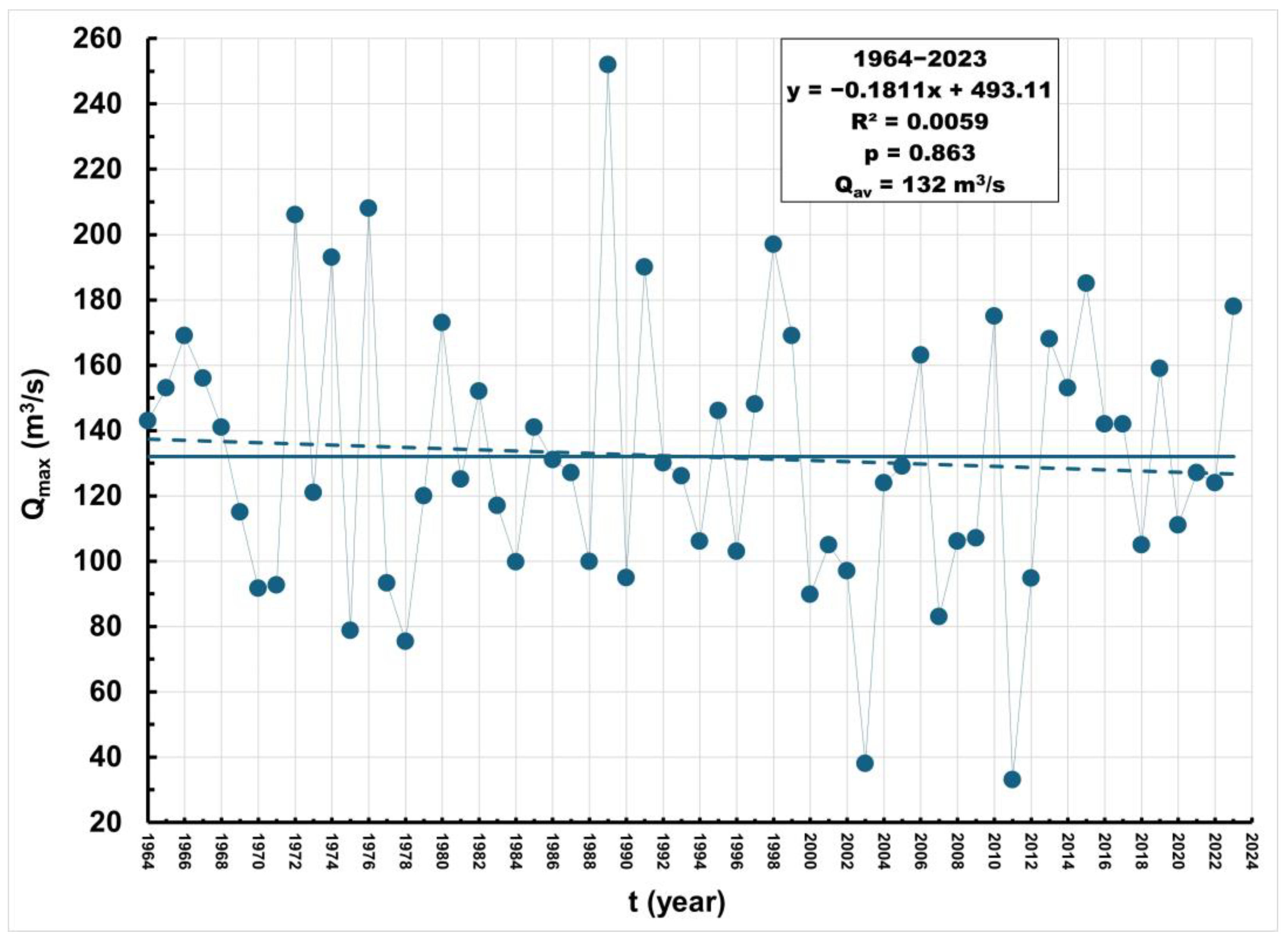
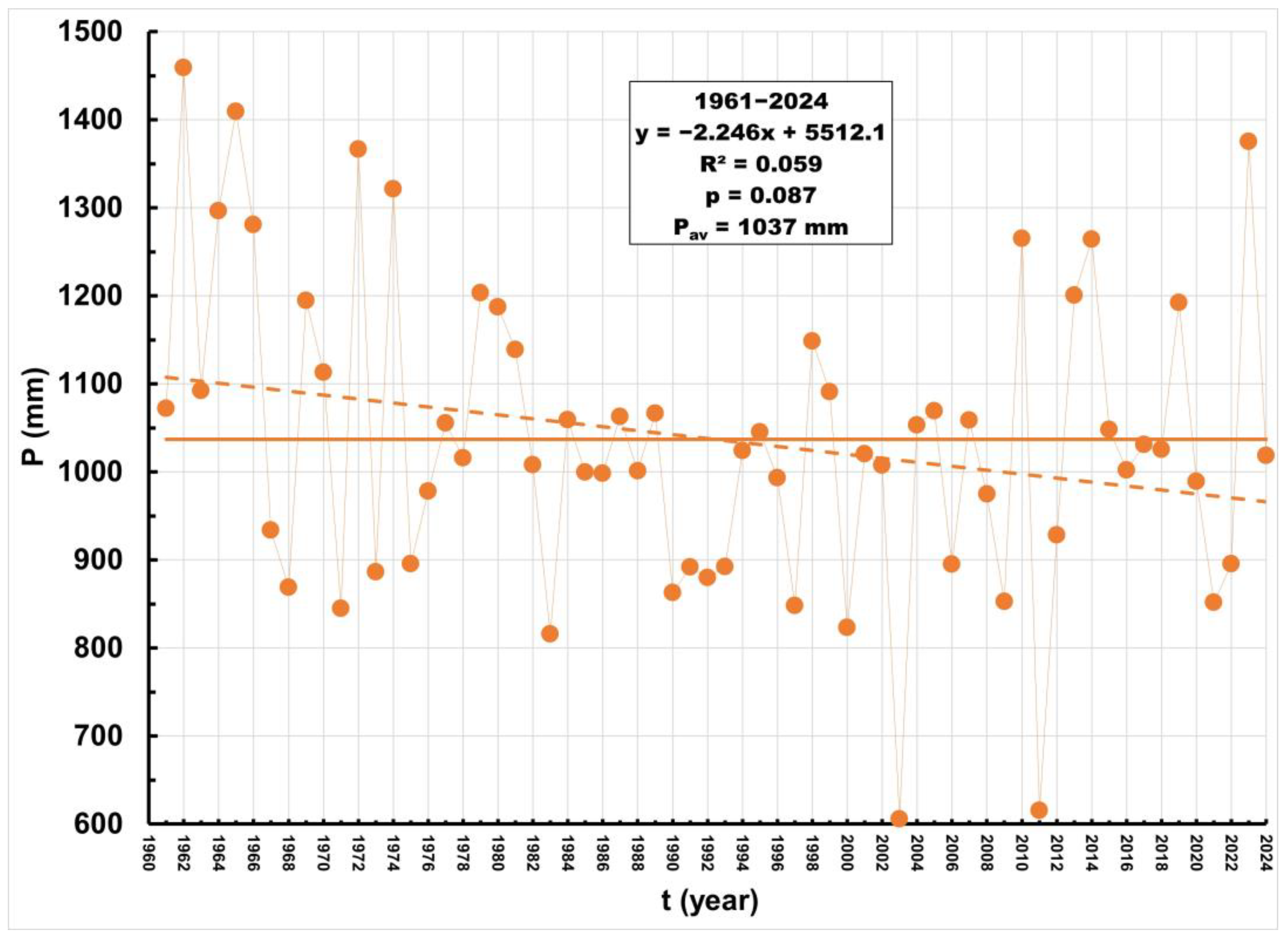

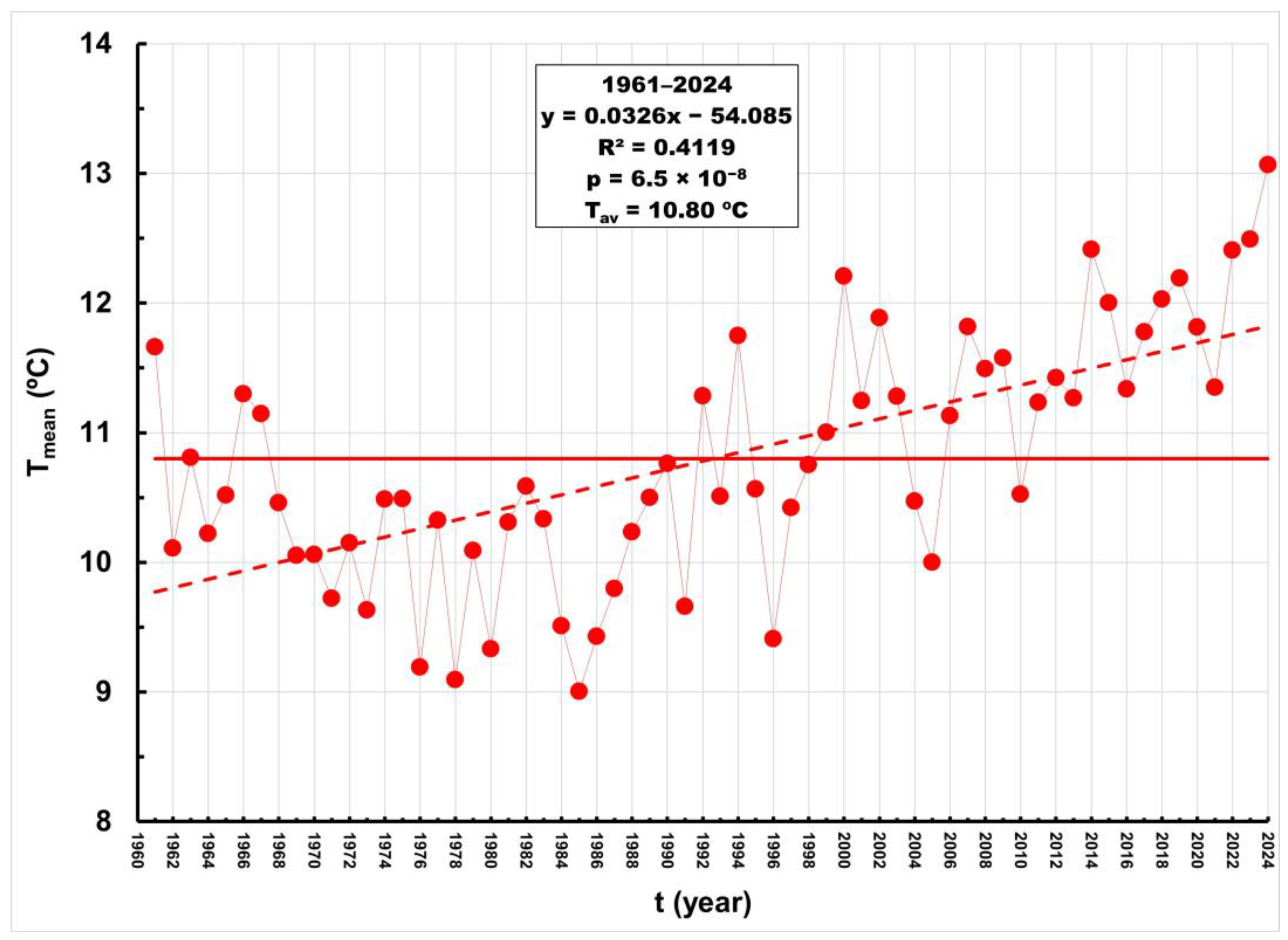

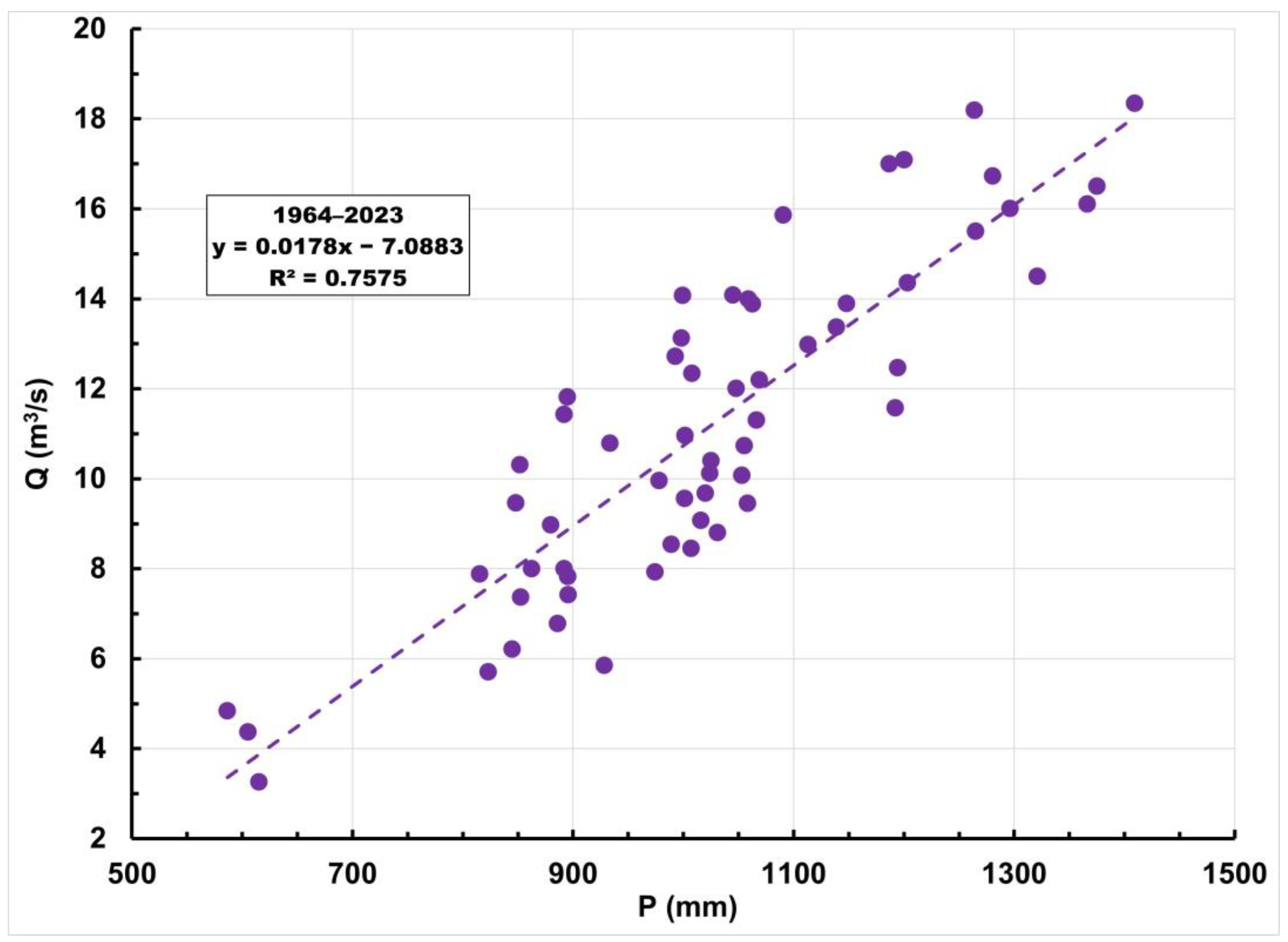
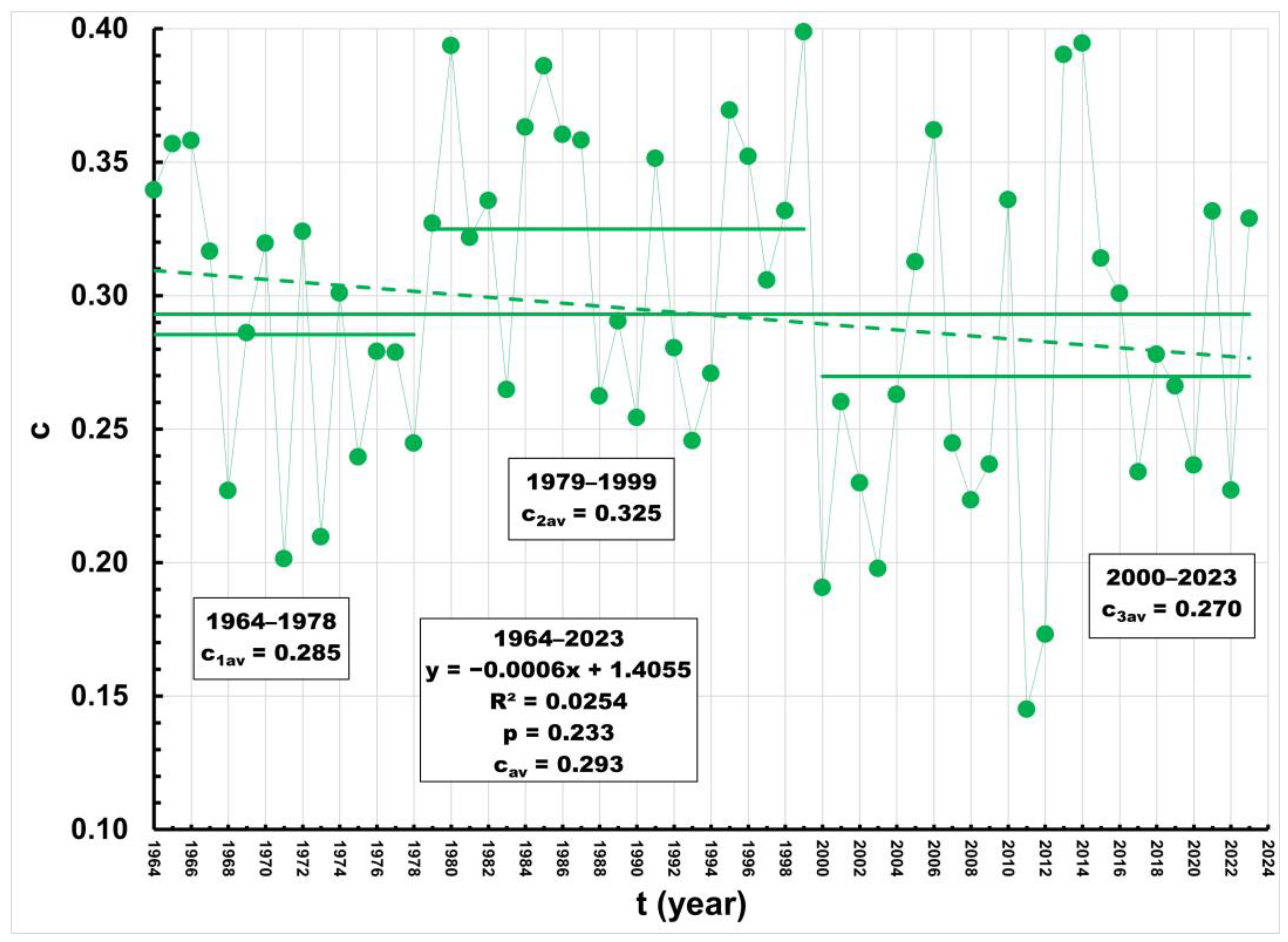




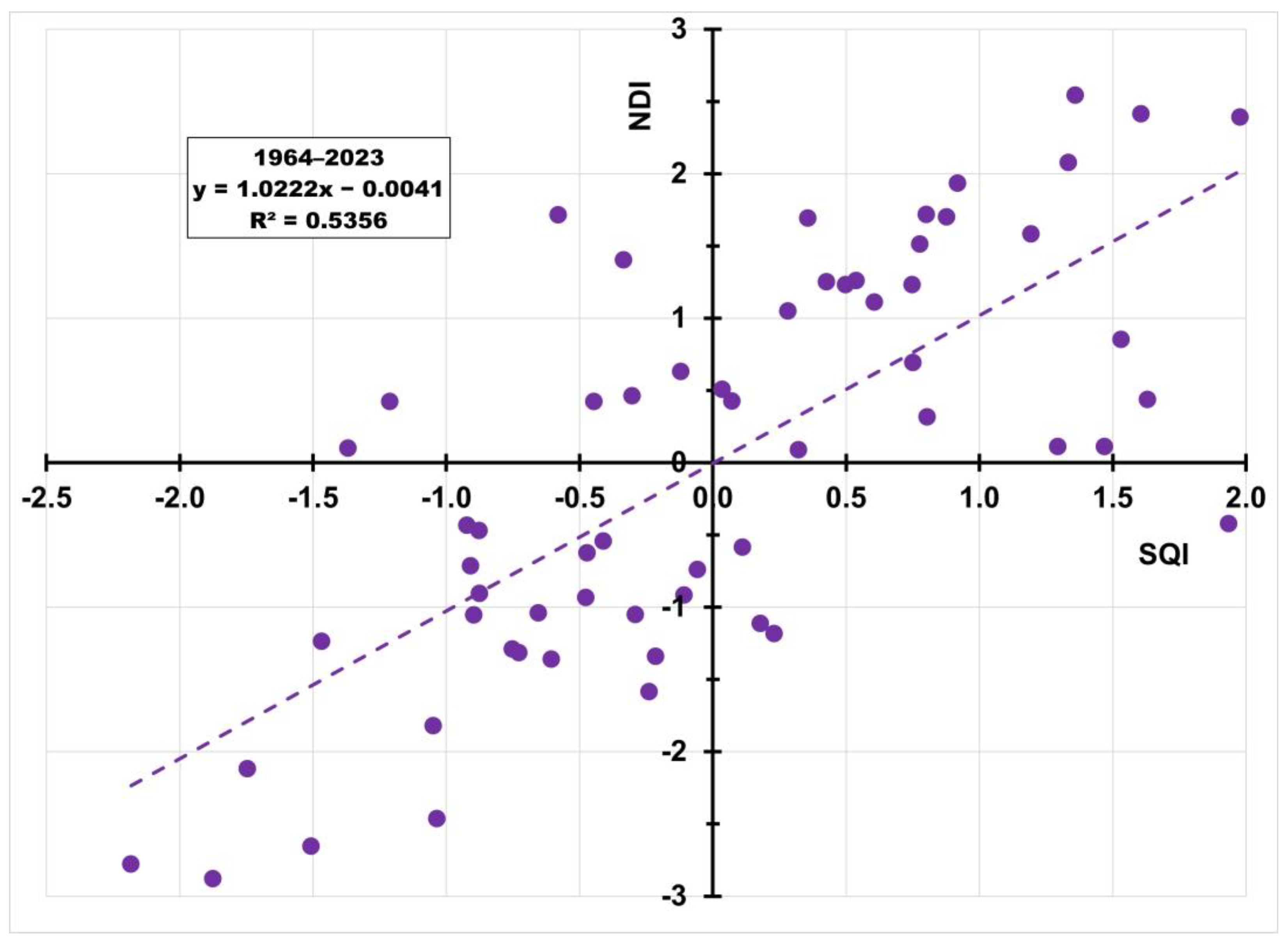

| Period | R2 (Q–P) | R2 (Q–T) | R2 (P–T) | RM2 |
|---|---|---|---|---|
| 1 | 2 | 3 | 4 | 5 |
| 1964–2023 | 0.758 | 0.0292 | 0.0004 | 0.78106 |
| 1964–1985 | 0.829 | 0.0141 | 0.0196 | 0.85959 |
| 1986–2023 | 0.693 | 0.0270 | 0.0132 | 0.72913 |
Disclaimer/Publisher’s Note: The statements, opinions and data contained in all publications are solely those of the individual author(s) and contributor(s) and not of MDPI and/or the editor(s). MDPI and/or the editor(s) disclaim responsibility for any injury to people or property resulting from any ideas, methods, instructions or products referred to in the content. |
© 2025 by the authors. Licensee MDPI, Basel, Switzerland. This article is an open access article distributed under the terms and conditions of the Creative Commons Attribution (CC BY) license (https://creativecommons.org/licenses/by/4.0/).
Share and Cite
Bonacci, O.; Žaknić-Ćatović, A.; Roje-Bonacci, T.; Bonacci, D. Assessing the Effects of Climate Change on the Hydrology of a Small Catchment: The Krapina River near Kupljenovo. Water 2025, 17, 1403. https://doi.org/10.3390/w17091403
Bonacci O, Žaknić-Ćatović A, Roje-Bonacci T, Bonacci D. Assessing the Effects of Climate Change on the Hydrology of a Small Catchment: The Krapina River near Kupljenovo. Water. 2025; 17(9):1403. https://doi.org/10.3390/w17091403
Chicago/Turabian StyleBonacci, Ognjen, Ana Žaknić-Ćatović, Tanja Roje-Bonacci, and Duje Bonacci. 2025. "Assessing the Effects of Climate Change on the Hydrology of a Small Catchment: The Krapina River near Kupljenovo" Water 17, no. 9: 1403. https://doi.org/10.3390/w17091403
APA StyleBonacci, O., Žaknić-Ćatović, A., Roje-Bonacci, T., & Bonacci, D. (2025). Assessing the Effects of Climate Change on the Hydrology of a Small Catchment: The Krapina River near Kupljenovo. Water, 17(9), 1403. https://doi.org/10.3390/w17091403






